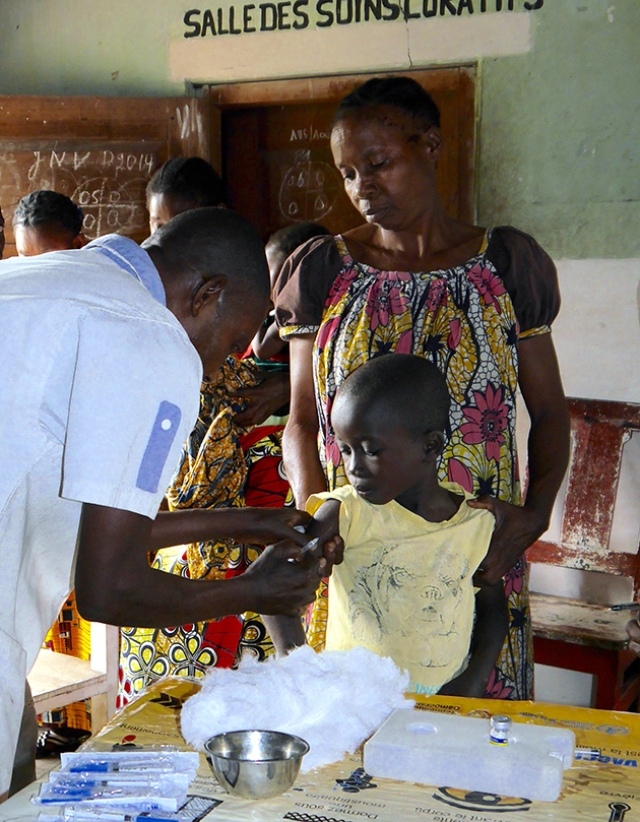DRC vaccinates more than 10 million people in Africa’s largest yellow fever vaccination campaign
 BRAZZAVILLE, 6 September 2016 – The largest emergency vaccination campaign against yellow fever ever attempted in Africa, came to an end on 5 September 2016 with more than 10.6 million people in the Democratic Republic of Congo (DRC) vaccinated against the lethal disease.
BRAZZAVILLE, 6 September 2016 – The largest emergency vaccination campaign against yellow fever ever attempted in Africa, came to an end on 5 September 2016 with more than 10.6 million people in the Democratic Republic of Congo (DRC) vaccinated against the lethal disease.
In just ten days, 7 807 653 people were vaccinated in the capital city of Kinshasa, most of them using an emergency vaccine – one fifth of the full dose of yellow fever vaccine. This dose-sparing strategy was recommended by the WHO Strategic Advisory Group of Experts on Vaccination (SAGE) as a short term emergency measure to reach as many people as possible given limited global vaccine supplies.
“WHO congratulates the DRC for successfully conducting this complex logistical emergency vaccination campaign in record time of 10 days including very hard to reach areas,” said Dr Matshidiso Moeti, WHO Regional Director for Africa. “It was a race against time to provide vaccine protection to the people most at risk from yellow fever before the rainy season, especially in the densely populated capital of Kinshasa.”
As of 5 September 2016, a further 2 844 157 people in five provinces (Kasaï Central, Kasaï, Kongo Central, Kwango and Lualaba) bordering Angola were also vaccinated to halt transmission between the two affected countries.
WHO and partners played a key role in ensuring the availability of the required millions of vaccine doses, syringes and other materials, as well as maintaining the cold chain to ensure vaccines are stored and transported in the right conditions. Together with national health authorities and health partners, WHO led the coordination efforts during the planning and implementation phases of the campaign, trained and supervised health workers, and engaged with communities and leaders in disseminating information about the campaigns.
WHO also deployed some 100 experts in epidemiology, data management, vaccination, risk communications and community engagement, logistics, laboratory diagnostics and clinical case management to support the planning, implementation of the government-led response in some 8000 locations across DRC together with partners.
“Vaccination remains the key strategy to control the largely urban yellow fever outbreak in the DRC as it is the most effective protection against yellow fever,” said Dr Matshidiso Moeti, WHO Regional Director for Africa. “WHO remains committed to support the Ministry of Health for the planned campaign next year when people who received an emergency dose in Kinshasa will get full dose as soon as global vaccine supplies return to normal.”
Since 22 March 2016 when the country first notified WHO of yellow fever cases, DRC has reported 2513 suspected cases of which 75 have been laboratory confirmed and 16 deaths. No new confirmed cases have been reported in the country since 12 July 2016 and the downward trend of cases continues around the country.
Three sylvatic cases have been reported in the rural forests of Tshuapa Province. These cases are unrelated to the current outbreak. Sylvatic (or jungle) yellow fever is transmitted by monkeys and occasionally humans working or travelling in jungle areas are bitten by infected mosquitoes. This type of yellow fever is less likely to spread widely due to its remote, rural location. Yellow fever is endemic to DRC.
____________________________________________
For further information and media enquiries, please contact:
Ebba Kalondo, Risk Communications Officer, at +243 991715425 or by email at kalondoe [at] who.int
Eugene Kabambi, Communications Officer, at +243 817 151 697 or by email at kabambie [at] who.int
Collins Boakye-Agyemang, Regional Communications Advisor, at +47 241 39420 or by email at boakyeagyemangc [at] who.int


